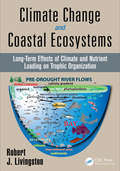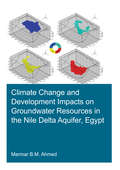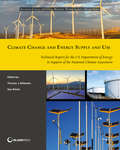- Table View
- List View
Climate Change and Atmospheric Deposition as Drivers of Forest Ecosystem Integrity and Services: A Methodology for Assessing and Mapping Ecosystem Services across Time and Space (SpringerBriefs in Environmental Science)
by Winfried Schröder Angela SchlutowThis book is intended to provide a hitherto missing English-language overview of a multi-year research project in which a comprehensive methodology was developed to assess a rule-based classification of the habitat services, the primary net biomass productivity and carbon sequestration capacity. The comprehensive methodology presented operationalises the specifications of the MAES working group quantitatively. The MAES classification framework for integrative ecosystem assessments comprises the mapping of ecosystems, the classification of ecosystem conditions (ecosystem condition information for individual indicators, ecosystem functions and ecosystem types), the classification of ecosystem services and their integration. The presented rule-based classification of the three ecosystem services examined in depth using quantitative indicators is unique in the EU to date.
Climate Change and Clean Energy Management: Challenges and Growth Strategies
by Henry K. WangClimate change has never been more important than it is now, as it has become arguably the world’s most urgent problem. Solving this problem is proving difficult and complex as it involves joint efforts by governments, companies, communities and innovators. The increased use of fossil fuels associated with global economic growths has led to rising GHG emissions and global warming. There are many challenges for countries that are enacting new climate and clean energy regulations in line with their Paris Agreement commitments. Good government policies and corporate strategies are essential to support these efforts as part of the global climate change crisis. This important book addresses the latest climate change impacts and developments in potential mitigation strategies. These include fossil to clean energy transition, smart low carbon city designs, green transportation, electric vehicles, green agriculture, carbon emission trading, carbon capture solutions plus climate finance and risk management. Potential new policies and strategies to support the successful implementation of these important strategic areas are discussed together with high-level country and business case examples. This book is essential reading for policy makers, government employees, business executives, professionals, researchers and academics alike looking to affect change to global climate and energy policies.
Climate Change and Coastal Ecosystems: Long-Term Effects of Climate and Nutrient Loading on Trophic Organization (CRC Marine Science)
by Robert J. LivingstonProduced by a Leading Aquatic ScientistA narrative account of how estuaries around the world are being altered by human forces and human-induced global climate changes, Climate Change and Coastal Ecosystems: Long-Term Effects of Climate and Nutrient Loading on Trophic Organization chronicles a more than 40-year-old research effort conducted by Dr.
Climate Change and Coastal Resources in Tanzania: Studies on Socio-Ecological Systems’ Vulnerability, Resilience and Governance (Springer Climate)
by Pius Zebhe Yanda Ian Bryceson Haji Mwevura Claude Gasper Mung'Ong'OThis volume synthesizes research from a five year program supported by the Norwegian Agency for Development to assess how coastal communities in Tanzania can adapt to climate change impacts such as sea level rise, and better assert their rights to implement decisions regarding coastal resource management in the context of global climate change. Throughout ten chapters, the book deploys a holistic approach to adopt a conceptual model of socio-ecological systems, and characterize human-nature interactions in an integrative way to understand anthropogenic pressures on ecosystems to guide conservation and management. The book will be of interest to researchers, students studying environmental management and climate change, planners, and policy makers. The book begins by describing the biophysical and socio-economic characteristics of the Tanzanian coastal environment, then discusses the impacts of climate change on coastal resource governance, community vulnerability, and livelihood security. Then, intervention strategies are offered as a means for local communities to not only adapt to climate change impacts, but also to engage in decision-making processes to assess vulnerabilities and address challenges and limitations through educated measures. The final chapters discuss the vulnerability and adaptation of coastal communities to climate change impacts to assess how livelihoods are constructed in response to impacts, and summarize the key findings to determine the best adaptation strategies to improve adaptive capacity and reduce socio-economic vulnerability.
Climate Change and Community Resilience: Insights from South Asia
by Pranab Mukhopadhyay A. K. Enamul Haque Mani Nepal Md Rumi ShamminThis open access book documents myriads of ways community-based climate change adaptation and resilience programs are being implemented in South Asian countries. The narrative style of writing in this volume makes it accessible to a diverse audience from academics and researchers to practitioners in various governmental, non-governmental and international agencies. At a time when climate change presents humanity with a gloomy future, the stories of innovation, creativity, grassroots engagement and locally applicable solutions highlighted in this book provides insights into hopeful ways of approaching climate solutions. South Asian countries have been dealing with the impact of climate change for decades and thus offer valuable learning opportunities for developing countries within and beyond the region as well as many western countries that are confronting the wrath of climate induced natural disasters more recently.SANDEE has been a pioneer in the development of research and training in environmental economics and related issues in South Asia and Prof Maler has been throughout SANDEE's history, its mentor, and its strongest supporter. Many young economists in South Asia have significantly benefited from Prof Maler's guidance and inputs. The present volume on “Climate Change and Community Resilience: Insights from South Asia” is a fitting tribute and an excellent reflection of Prof Maler's contributions to the SANDEE programme throughout his association.- Mahesh Banskota, Ph.D.Professor, Development StudiesSchool of Arts, Kathmandu UniversityThis comprehensive volume aptly identifies grassroots initiatives as the core of the problem of adaptation to climate change. The analysis of the different experiments is lucid, inclusive, and full of interesting detail. The methodologies used and the subjects covered span a range of frameworks and narratives. Put together, the studies are a fitting tribute to Karl-Goran Maler, who spent years putting his impeccable expertise to use for the cause of enhancing research in South Asia.- Kanchan Chopra, Ph.D.Former Director and Professor, Institute of Economic Growth, Delhi, and Fellow, SANDEEThe slow international policy response to climate change elevates the importance of understanding how communities can respond to climate change’s many threats. This unusually accessible volume provides that understanding for South Asia while being relevant to the rest of the world. Its emphasis on research by scholars from the region makes it a wonderful tribute to Prof. Karl-Göran Mäler, who contributed so much to the growth of environmental economics research capacity in South Asia.- Jeffrey R. Vincent, Ph.D.Clarence F. Korstian Professor of Forest Economics & ManagementNicholas School of the Environment, Duke University, USA
Climate Change and Conservation of Coastal Built Heritage
by Maya Hassan Hui XieThis book presents the preservation principles and the current environmental challenges relating to monitoring heritage sites and buildings under the effects of climate change. It provides a clear overview of conservation action levels and the importance of participation and cooperation between them, and discusses evaluation and management methods, thermal comfort for the common usages, and conceptual methods for enhancing the built heritage. The research presented employed the “Zoom In, Zoom Out” approach for monitoring the Syrian coastal heritage sites threatened by the direct and indirect effects of climate change. Lastly, the book establishes the basic principles and conservation strategies for preserving the coastal heritage sites and buildings. As such, it is a valuable reference resource for researchers, developers, architects, and conservators involved in protecting the architectural heritage in coastal areas. It can also be used as a guidebook on preserving and monitoring built heritage sites at both macro and micro levels.
Climate Change and Cotton Production in Modern Farming Systems
by K. J. Broughton Q. Luo D. M. Oosterhuis Y. Osanai P. Payton D. T. Tissue B. K. Singh P. Bauer K Reddy Michael P Bange G. Constable J. BakerThroughout the world cotton is broadly adapted to growing in temperate, sub-tropical, and tropical environments, but growth may be challenged by future climate change. Production may be directly affected by changes in crop photosynthesis and water use due to rising CO2 and changes in regional temperature patterns. Indirect effects may result from a range of government regulations aimed at climate change mitigation. While there is certainty that future climate change will impact cotton production systems; there will be opportunities to adapt. This review begins to provide details for the formation of robust frameworks to evaluate the impact of projected climatic changes, highlight the risks and opportunities with adaptation, and details the approaches for investment in research. Ultimately, it is a multi-faceted systems-based approach that combines all elements of the cropping system that will provide the best insurance to harness the change that is occurring, and best allow cotton industries worldwide to adapt. Given that there will be no single solution for all of the challenges raised by climate change and variability, the best adaptation strategy for industry will be to develop more resilient systems. Early implementation of adaptation strategies, particularly in regard to enhancing resilience, has the potential to significantly reduce the negative impacts of climate change now and in the future.
Climate Change and Cotton Production in Modern Farming Systems (ICAC Reviews)
by Q. Luo Y. Osanai P. Payton P. Bauer K Reddy Michael P Bange G. Constable J. Baker K. J. Broughton D. M. Oosterhuis D. T. Tissue B. K. SinghThroughout the world cotton is broadly adapted to growing in temperate, sub-tropical, and tropical environments, but growth may be challenged by future climate change. Production may be directly affected by changes in crop photosynthesis and water use due to rising CO2 and changes in regional temperature patterns. Indirect effects may result from a range of government regulations aimed at climate change mitigation. While there is certainty that future climate change will impact cotton production systems; there will be opportunities to adapt. This review begins to provide details for the formation of robust frameworks to evaluate the impact of projected climatic changes, highlight the risks and opportunities with adaptation, and details the approaches for investment in research. Ultimately, it is a multi-faceted systems-based approach that combines all elements of the cropping system that will provide the best insurance to harness the change that is occurring, and best allow cotton industries worldwide to adapt. Given that there will be no single solution for all of the challenges raised by climate change and variability, the best adaptation strategy for industry will be to develop more resilient systems. Early implementation of adaptation strategies, particularly in regard to enhancing resilience, has the potential to significantly reduce the negative impacts of climate change now and in the future.
Climate Change and Crop Production
by Matthew P. ReynoldsThis book will provide an overview of the essential disciplines required for sustainable crop production in unpredictable environments. Chapters include discussions of adapting to biotic and abiotic stresses, sustainable and resource-conserving technologies and new tools for enhancing crop adaptation.
Climate Change and Crop Production: Foundations for Agroecosystem Resilience (Advances in Agroecology)
by Noureddine BenkebliaPresenting an overview of agroecology within the framework of climate change, this book looks at the impact of our changing climate on crop production and agroecosystems, reporting on how plants will cope with these changes, and how we can mitigate these negative impacts to ensure food production for the growing population. It explores the ways that farmers can confront the challenges of climate change, with contributed chapters from around the world demonstrating the different challenges associated with differing climates. Examples are provided of the approaches being taken right now to expand the ecological, physiological, morphological, and productive potential of a range of crop types. Describes the effects and responses of the macro and micro levels of crops under the different components of climate change Reports on the adaptation and resilience of food production systems within the changing climate Covers how plants cope with the changing climate including physiological, biochemical, phenotype, and ecosystem responses Provides an in-depth discussion on the importance of agricultural education connected to climate change Giving readers a greater understanding of the mechanisms of plant resilience to climate change, this book provides new insights into improving the productivity of an individual crop species as well as bringing resistance and resiliency to the entire agroecosystem. It offers a strong foundation for changing research and education programs so that they build the resistance and resilience that will be needed for the uncertain climate future ahead.
Climate Change and Development Impacts on Groundwater Resources in the Nile Delta Aquifer, Egypt (IHE Delft PhD Thesis Series)
by Marmar Badr AhmedClimate change is likely to continue to have severe impacts, including sea level rise. At the same time, population increase and development imperatives create additional pressure on available water resources. These changes are problematic for the Mediterranean coastal areas and especially the Nile Delta coast. Particular focus of this study is on salinization of groundwater resources in the Nile Delta Aquifer (NDA) due to saltwater intrusion. To assess current conditions and develop future adaptation strategies for the NDA, a 3D model simulating regional variable-density groundwater flow and coupled salt transport was constructed based on available data set, using the SEAWAT code. A method for identification of the most representative model has been developed, based on testing different simulation periods during which the NDA has ‘evolved’ from completely fresh groundwater conditions to conditions representative for the year 2010.This model was then applied to analyze possible future NDA conditions under several predefined scenarios of sea level rise and groundwater extraction. This analysis indicated that the impacts from further extractions of groundwater on availability of fresh groundwater in the aquifer are more significant compared to those from sea level rise. Furthermore, three different adaptation measures and their impacts in the Sharkeya Nile Delta governorate were tested. It was shown that that changing crop types and irrigation practices towards water saving options seem to be more promising than artificial recharge with injection wells or extraction and usage of brackish groundwater after desalination. The developed model is useful for further Water-Food Nexus studies.
Climate Change and Disaster Risk Management (Climate Change Management #0)
by Walter Leal FilhoThere has been some degree of reluctance in the past to consider disaster risk management within the mainstream of adaptation to climate variability and climate change. However, there is now wide recognition of the need to incorporate disaster risk management concerns in dealing with such phenomena. There is also a growing awareness of the necessity for a multi-sectoral approach in managing the effects of climate variability and climate change, since this can lead to a significant reduction of risk. This book presents the latest findings from scientific research on climate variation, climate change and their links with disaster risk management. It showcases projects and other initiatives in this field that are being undertaken in both industrialised and developing countries, by universities and scientific institutions, government bodies, national and international agencies, NGOs and other stakeholders. Finally, it discusses current and future challenges, identifying opportunities and highlighting the still unrealised potential for promoting better understanding of the connections between climate variation, climate change and disaster risk management worldwide.
Climate Change and Ecosystems: Challenges to Sustainable Development (Footprints of Climate Variability on Plant Diversity)
by Shah FahadThe global population is projected to increase by 3.3 billion from 6.7 billion in 2008 to 10 billion in 2100. As a result, soil degradation and desertification are growing due to the increasing demand for food, feed, fiber, and fuel on finite soil resources. The problem of global food insecurity may be further worsened by the threat of global warming. Climate change is showing its impacts in terms of increasing temperatures, variable rainfall, and an increase in climate-related extremes such as floods, droughts, cyclones, sea-level rise, salinity, and soil erosion. The agriculture sector is the most sensitive to climate change because the climate of a region/country determines the nature and characteristics of vegetation and crops. Increase in the mean seasonal temperature and decrease in effective precipitation can reduce the duration of many crops, may lead to outbreaks of pests and diseases, and hence reduce final yield ultimately affecting the food security of the country. Despite the positive impact of CO2 fertilization, the net productivity may decrease because of an increase in respiration rate, drought stress, and nutrient deficiency. For example, for every 75 ppm increase in CO2 concentration, rice yields will increase by 0.5 t/ha, but the yield will decrease by 0.6 t/ha for every 1°C increase in temperature. The global agricultural productivity is expected to decrease from 3% to 16% by 2080. The estimated decrease in agricultural productivity in the developing countries is 10%–25% in the 2080s, where average air temperature is already near or above crop tolerance levels. This book is intended to serve as a stimulating collection that will contribute to debate and reflection on the sustainable future of agriculture and food production in the face of global change.Features: This book brings together a multidimensional group of international scholars exploring the ethical dimensions of climate change and ecosystem. New strategies have been pointed out in this book for better sustainable development. This book has been designed to provide a good overview of major challenges facing policymakers, researchers, and ultimately humankind in dealing with climate change. This book summarizes the diverse features of vulnerability, adaptation, and amelioration of climate change in respect to plants, crops, soil, and microbes for the sustainability of the agricultural sector, and, ultimately, food security for the future. This book provides a state-of-the-art description of the physiological, biochemical, and molecular status of the understanding of abiotic stress in plants.
Climate Change and Energy Dynamics in the Middle East: Modeling and Simulation-Based Solutions (Understanding Complex Systems)
by Hassan Qudrat-Ullah Aymen A. KayalThis edited volume presents chapters on the dynamics of global climate change and global warming in the Middle East. In this region, it should be noted that even slightly warmer weather can result in an increased demand of energy along with its lower supply, as well as lower labor productivity. This text focuses on modeling, simulation, system dynamics, and agent-based modeling in dealing with these issues. The latest decision making tools, techniques, and innovative solutions used to overcome these challenges are presented.Many distinguished researchers contribute their work herein. The audience for this volume includes policy makers, researchers, and students unified by the common goal of making better decisions in the sustainable production and consumption of energy. The practical orientation of the chapters within each part is intended to suit the practitioners: managers and decision makers in the energy sector of the Middle East region.
Climate Change and Energy Supply and Use: Technical Report for the U.S. Department of Energy in Support of the National Climate Assessment (NCA Regional Input Reports)
by Thomas J. WilbanksDeveloped to inform the 3rd National Climate Assessment, and a landmark study in terms of its breadth and depth of coverage and conducted under the auspices of the U. S. Department of Energy, Climate Change and Energy Supply and Use examines the known effects and relationships of climate change variables on energy production and supply, including oil, gas, thermal electricity, and renewable energy. Knowledge of today's available energy forms is constantly surfacing and changing in the face of climate change, making it increasingly important to enhance communication about various energy supplies. This report on energy supply and use summarizes current knowledge, especially emerging findings, about implications of climate change for energy production and supply (oil and gas, thermal electricity, renewable energy, integrated perspectives, and indirect impacts on energy systems). A comprehensive resource for community planners and researchers, it discusses future risk-management strategies surrounding water treatment, heating or cooling, and mitigation that the country can utilize in its energy consumption. The authors analyze findings from their own research and practice to arrive at conclusions about vulnerabilities, risks, and impact concerns for different aspects of U. S. energy supply and use. Global and national policy contexts are informed by these efforts to create energy options and choices. Rich in science and case studies, Climate Change and Energy Supply and Use offers decision makers and stakeholders a substantial basis from which to make informed choices that will affect energy risk-management in the decades to come.
Climate Change and Environmental Degradation in the MENA Region (The Handbook of Environmental Chemistry #136)
by Abdelazim Negm Ayad Al-Quraishi Brahim BenzougaghThis book reviews the factors contributing to the degradation of natural resources in the MENA region caused by climate change and contamination. It examines how these issues affect humans, their health, resources, and the planet's future. The impact of climate change is evident in the diminishing quality of land, water, and air, which leads to several environmental problems such as drought, land degradation, vegetation decline, reduced water bodies, soil damage, and other ecological concerns. Divided into 21 chapters, the book comprehensively analyses the risks brought about by climate change and environmental pollution. The chapters are contributed by a diverse team of authors from various countries in the MENA region, who offer a comprehensive overview of recent technologies, future developments, and several case studies analyses. In this book, readers will find topics such as: Impact of climate change, saline irrigation water, and other factors on soil degradation and carbon and nitrogen cycling in the MENA region Desertification, flood-storms, contamination, and their effects on natural resources and sustainability in the region Impact of recycled scrap steel on soil contamination, agriculture wastewater on lakes degradation and water pollution, and the effects of wastewater on agriculture Consequences of mismanaging natural resources and their influence on the environment interrelation between Greenhouse Gas Emissions, Climate Change, and the deterioration of natural resources Application of non-conventional methods to address natural resource issues. This book calls for action to protect natural resources and the environment. These measures may include enacting legislation and regulations to restrict human activities, developing public understanding of the necessity of environmental protection against climate change and environmental contamination, and supporting sustainable behaviours to preserve natural resources. Given its breadth, the book appeals to scholars, researchers, and policymakers alike.
Climate Change and Environmental Sustainability (Advances in Science, Technology & Innovation)
by Joni Jupesta Deo Prasad Bao-Jie He Gloria PignattaThis book discusses the challenges related to climate change mitigation and adaptation. It adds valuable strategies and insights into the development of new practices solving the identified social and economic problems related to ecosystem deterioration and anticipating other disasters related to climate change. As the decarbonization of cities and communities became an issue of great interest to many researchers, the book in hands will be of great importance to decision-makers and energy stakeholders and others seeking a more resilient and sustainable future and developing innovative technologies to overcome environmental deterioration.This book is a culmination of selected research papers from the first version of the international conference on ‘Climate Chance and Environmental Sustainability’ which was held in 2021 in collaboration with Chongqing University, China.
Climate Change and Food Security in South Asia
by Rattan Lal A.H.M. Mustafizur Rahman Khandakar R. Islam Mannava Vk Sivakumar S.M.A. FaizThis book addresses an important topic of food security in South Asia with specific reference to climate change. Of the 1 billion food insecure people in the world, more than 30% are in South Asia. The problem of food insecurity may be exacerbated by the projected climate change especially because of the water scarcity caused by rapid melting of the glaciers in the Himalayas and increase in variability in monsoonal rains and frequency of extreme events. Furthermore, large populations of Bangladesh and other coastal regions may be displaced by sea level rise. Thus, this volume addresses recommended land use and soil/water/crop/vegetation management practices which would enable land managers to adapt to climate disruption by enhancing soil/ecosystem/social resilience. In addition to biophysical factors, this book also addresses the issues related to human dimensions including social, ethnical and political considerations.
Climate Change and Food Security in West Asia and North Africa
by Rattan Lal Mannava Sivakumar Ibrahim Hamdan Ramasamy SelvarajuThe countries of West Asia and North Africa (WANA) have long had the challenge of providing sustainable livelihoods for their populations in the fragile ecosystems of semi-arid and arid areas. Climate change is already a reality in WANA and it places additional constraints on the already fragile ecosystems of dry areas and limited natural resources in WANA. A comprehensive and integrated approach to planning and implementing the climate change adaptation strategies across the wide range of agro-ecosystems in different countries in WANA could help both the planners and the local communities to deal effectively with the projected impacts and also contribute to overall sustainability of agricultural production systems. This book addresses the important issue of climate change and food security in West Asia and North Africa and presents the appropriate strategies which could help in the development of new policies to better adapt agriculture production systems and enhance food security in WANA.
Climate Change and Food Security: Adapting Agriculture to a Warmer World (Advances in Global Change Research #37)
by David B. Lobell Marshall BurkeRoughly a billion people around the world continue to live in state of chronic hunger and food insecurity. Unfortunately, efforts to improve their livelihoods must now unfold in the context of a rapidly changing climate, in which warming temperatures and changing rainfall regimes could threaten the basic productivity of the agricultural systems on which most of the world's poor directly depend. But whether climate change represents a minor impediment or an existential threat to development is an area of substantial controversy, with different conclusions wrought from different methodologies and based on different data. This book aims to resolve some of the controversy by exploring and comparing the different methodologies and data that scientists use to understand climate's effects on food security. In explains the nature of the climate threat, the ways in which crops and farmers might respond, and the potential role for public and private investment to help agriculture adapt to a warmer world. This broader understanding should prove useful to both scientists charged with quantifying climate threats, and policy-makers responsible for crucial decisions about how to respond. The book is especially suitable as a companion to an interdisciplinary undergraduate or graduate level class.
Climate Change and Global Food Security
by Rattan Lal David O. Hansen B. A. StewartIn order to feed their burgeoning populations, developing nations will need to double cereal production by the year 2050. This increase will have to come from existing land, as little potential exists for bringing new land under cultivation -- a daunting prospect when one realizes that increased use and significantly higher concentrations of carbon
Climate Change and Health Hazards: Addressing Hazards to Human and Environmental Health from a Changing Climate (Climate Change Management)
by Walter Leal Filho Diogo Guedes Vidal Maria Alzira Pimenta DinisThis book contains a set of papers which explore the links among climate change, health, and hazards and demonstrate how they interact. It emphasizes the urgency of immediate and more ambitious action to address climate risks. According to the Intergovernmental Panel on Climate Change (IPCC), human-induced climate change is known to be causing dangerous and widespread disruptions in nature and is affecting the lives of billions of people around the world, despite efforts to reduce the risks. Climate change is also negatively influencing health and is mounting threat to our wellbeing and a healthy planet. The world is also facing significant climate hazards over the next two decades, with global warming expected to soon reach 1.5°C. Even temporarily exceeding this warming level will result in additional severe impacts, some of which may be irreversible. There is therefore a perceived need for publications which may foster a greater understanding of how climate change connects to human health and the role played by hazards in this context. It is against this background that this book is being prepared.
Climate Change and Infectious Fish Diseases
by Patrick T.K. Woo Jo-Ann Leong Kurt BuchmannClimate change with global warming is not disputed by the vast majority of scientists and the aquatic system is most affected. A global rise in water temperature and acidification of the aquatic environment will continue even if we can significantly reduce the current output of the two most important greenhouse gasses (carbon dioxide and methane). These and other environmental changes will affect fish health which includes infectious pathogens. This important new text is the second volume on climate change and fish health. It covers changes to the freshwater ecosystem and their current and expected effects on selected infectious diseases of fish. The book represents contributions by over 50 experts from 18 countries. Comprehensive and thought-provoking, the book details abiotic and biotic environmental changes in temperate and tropical freshwater ecosystems, sequestrations of atmospheric carbon dioxide and effects on infectious diseases (12 microbial and 10 parasitic) in economically important fish in tropical, subtropical and temperate waters. The text is key reading for fish disease scientists, aquatic ecologists, fish health consultants, veterinarians, policy makers and all who are interested in fish health and the environment.
Climate Change and Legumes: Stress Mitigation for Sustainability and Food Security
by Doongar R. Chaudhary Hossain Anawar Mohammad Zabed HossainGlobal climate change has created unprecedented challenges for human civilization due to its widespread adverse consequences, including a reduction in crop yield and threatening food security across the globe. Among the crop plants, legumes have great potential for ameliorating global warming since they can reduce carbon emissions by lowering reliance on the application of chemical fertilizers, by increasing nitrification and carbon sequestration in soil, and by providing protein-rich diets to both humans and livestock. This book identifies the extent of climate-induced stresses on legume plants and focuses on achieving food security through sustainable agricultural practices.This book compiles recent research findings and reviews on climate-related problems, the potential of legumes in ameliorating the impacts of climate change, as well as better management of agricultural land and practices for achieving environmental sustainability and food security.This book will serve as guidelines for scientists, agricultural practitioners, and policymakers working to achieve food security and better management of climate-induced stresses in agricultural interventions. It will also be useful as a reference book for researchers and students of both graduate and postgraduate levels. Furthermore, this book will provide enhanced knowledge about the mechanisms of yield and stress tolerance of legumes as well as developing climate-smart crops and improving cropping systems for a sustainable environment and food security. Features of the book Reviews trends of global climate change and its consequences for food security across the continents Identifies the challenges and scopes of cultivating legumes in achieving food security in the context of global climate change Focuses on the improvements of legume production through conservation approaches in agricultural practices and modern techniques, including omics-based breeding, biotechnology, genetic engineering, and rhizobium technology Discusses the sustainable amelioration options for soils affected by climate-induced stresses Cites examples of applications of rhizobium technologies in reducing greenhouse gas emission Describes pathways associated with yield, resistance, and tolerance of legumes to climate-induced stresses
Climate Change and Managed Ecosystems
by R. Lal J. S. Bhatti M. J. Apps M. A. PriceFeaturing contributions from leading experts in the field, Climate Change and Managed Ecosystems examines the effects of global climate change on intensively constructed or reconstructed ecosystems, focusing on land use changes in relation to forestry, agriculture, and wetlands including peatlands. The book begins by discussing the fragility of eco























